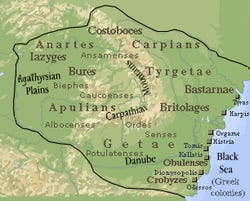Dacia- famed in antiquity for its immense wealth in gold and silver.
Ancient Dacia – a land encompassing much of modern-day Romania—was famed in antiquity for its immense wealth in gold and silver. Archaeological evidence shows that the Dacians had developed a rich culture of craftmanship by the 5th to 4th centuries BC. Gold and silver ornaments, pendants, and rings, used as trade items or as offerings to the gods, can be traced back to around 350 BC.1
Dacian Helmet of Coțofenești and other Artifacts Stolen from the Drents Museum
The Helmet of Coțofenești and other Romanian artifacts were stolen in January, 2025 from the Drents Museum in Assen, Netherlands.2
The stolen artifacts, valued at approximately €6 million, include the Helmet of Coțofenești—an irreplaceable 2,500-year-old golden helmet from the Dacian civilization—and three gold bracelets, all on loan from the National History Museum of Romania in Bucharest. The thieves used explosives to break into the museum, targeting the "Dacia: Empire of Gold and Silver" exhibition.
The artifacts were insured for €5.8 million, with the Dutch government guaranteeing over €9 million of the exhibition’s total €30 million insurance value, meaning taxpayers could bear significant costs if the items are not recovered.
The theft has caused outrage in Romania, leading to the firing of the National History Museum’s director and criticism of the loan agreement. The Drents Museum, reopened on January 31, 2025, after a temporary closure, remains hopeful for the artifacts’ return. A €250,000 reward offered by Dutch entrepreneur Alex van Breemen persists as an incentive for information leading to their recovery.
Suspects Arrested
Police were alerted following reports of an explosion at 3:45 a.m. local time on 25 January. There was no guard in the museum at the time of the theft.3 Security camera footage at the site later revealed three hooded people carrying a duffle bag, a crowbar and flashlights before the explosion.4
Three suspects were arrested on January 29, 2025, in Heerhugowaard, North Holland. A fourth suspect, was arrested on February 20, 2025. Evidence includes DNA on clothing found near the crime scene, a burned Volkswagen Golf, and a suspected switch to a black Ford Transit.
Artifacts Still Missing
Despite the arrests, the stolen artifacts have not been recovered. The police have prioritized their retrieval, releasing photos and names of arrested suspects However, the suspects have remained silent, raising concerns that the items may have been melted down for their gold value.
The Dutch police, working with Interpol and a team of dozens of detectives, continue to investigate. Hundreds of tips have been received, but no breakthrough has been reported. The golden artifacts remain missing as of April 7, 2025, with fears they may have been destroyed or sold on the black market. The investigation continues with urgency, but no definitive resolution has been achieved.
Echoes of ancient Dacia, A new exhibition at the Drents Museum tells the story of the Dacians through their spectacular treasures. World Archaeology November 19, 2024.
Gamboa, Carlota. Ancient Romanian Artifacts Stolen From Dutch Museum. Art & Object January 29, 2025.
Wizenich, Eli. Art Thieves Blew Up a Dutch Museum’s Door to Steal an Ancient Golden Helmet From Romania: The blast took place in the middle of the night, allowing the burglars to abscond with four valuable objects connected to Romania’s cultural heritage. Smithsonian Magazine, January 27, 2025.
Holland, Oscar."Thieves blow up museum door and steal ancient artifacts, including 2,500-year-old gold helmet," CNN, January 27, 2025.
Aikman, Ian (26 January 2025). "Thieves use explosives to steal gold 'masterpieces' from Dutch museum". BBC.
Aikman, Ian (26 January 2025). "Thieves use explosives to steal gold 'masterpieces' from Dutch museum". BBC.









